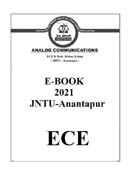

Note: Please check your Spam or Junk folder, in case you didn't receive the email with verification code.
SYLLABUS
UNIT-1
Introduction: Elements of communication systems, Information, Messages and Signals, Modulation, Modulation Methods, Modulation Benefits and Applications. Amplitude modulation & demodulation: Baseband and carrier communication, Amplitude Modulation (AM), Rectifier detector, Envelope detector, Double sideband suppressed carrier (DSB-SC) modulation & its demodulation, Switching modulators, Ring modulator, Balanced modulator, Frequency mixer, sideband and carrier power of AM, Generation of AM signals, Single sideband (SSB) transmission, Time domain representation of SSB signals & their demodulation schemes (with carrier, and suppressed carrier), Generation of SSB signals, Vestigial sideband (VSB) modulator & demodulator, Frequency division multiplexing (FDM), Illustrative Problems.
UNIT-2
Angle modulation & demodulation: Concept of instantaneous frequency, Generalized concept of angle modulation, Bandwidth of angle modulated waves – Narrow band frequency modulation (NBFM) and Wide band FM (WBFM), Phase modulation, Verification of Frequency modulation bandwidth relationship, Features of angle modulation, Generation of FM waves-Indirect method, Direct generation; Demodulation of FM, Band pass limiter, Practical frequency demodulators, Small error analysis, Pre-emphasis, & De-emphasis filters, FM Capture Effect, Illustrative Problems.
UNIT-3
Noise in communication systems: Thermal noise, Time domain representation of narrowband noise, filtered white noise, Quadrature representation of narrowband noise, Envelope of narrowband noise plus sine wave, Signal to noise ratio & probability of error, Noise equivalent bandwidth, Effective noise temperature, and Noise figure, Baseband systems with channel noise, Performance analysis (i.e. finding SNR expression) of AM, DSB-SC, SSB-SC, FM, PM in the presence of noise, Illustrative Problems.
UNIT-4
Analog pulse modulation schemes: Pulse amplitude modulation – Natural sampling, flat top sampling and Pulse amplitude modulation (PAM) & demodulation, Pulse-Time Modulation – Pulse Duration and Pulse Position modulations, and demodulation schemes, PPM spectral analysis, Illustrative Problems. radio receiver: Working principle of Super heterodyne AM and FM Receivers along with suitable block diagrams, Sensitivity, Selectivity and fidelity.
UNIT-5
Information Theory: Introduction, Information and Entropy, and its properties, source coding Theorem, Data Compaction – Prefix coding, Huffman coding, Discrete Memoryless channels, Mutual Information, and its properties, Channel capacity, Channel coding Theorem, Application to binary symmetric channels, differential entropy and mutual information, Information capacity theorem, implication of information capacity theorem, Rate Distortion, Illustrative problems.
 No Preview is available for this book
No Preview is available for this book

 Get 100 instant uPoints on the purchase of Rs.100 or above for each order.
Get 100 instant uPoints on the purchase of Rs.100 or above for each order.
CategoriesElectronics & Communication

Format PDF

TypeeBook